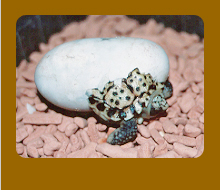
 |
|
Studbooks on Chersobius and Homopus species Click to proceed directly to the current studbook overviews: C. boulengeri - C. signatus - H. areolatus - H. femoralis History and aims of studbooks In the international zoo community, mammalian and avian studbooks have a long history. Following this concept, several Dutch herpetological societies joined to initiate private studbooks on reptile and amphibian species in 1992. In 1997, all studbooks were condensed into an independent foundation known as "Stichting Overkoepelend Orgaan Stamboeken", now known as European Studbook Foundation (ESF). As this moment, several dozens of studbooks include private participants and zoos, in Europe and occasionally overseas. The aims of the herp studbooks in general are:
The Chersobius and Homopus studbooks are coordinated by a coordinator at Dwarf Tortoise Conservation, and co-supervised by the European Studbook Foundation. Keepers of species for which a studbook exists can apply for registration. Only specimens that are present legally can be registered. Registration occurs by sending us a message for instructions. When the specimens have been registered, the keeper (now participant) receives studbook registration numbers for his animals. Registration is voluntarily; specimens can be withdrawn at any moment and there will never be advises (for instance about transferring specimens in order to form suitable breeding groups) that must be followed. However, all persons involved in a studbook are supposed to share the same general view on studbooks and studbook management (preventing inbreeding, maintaining genetic diversity, sharing of information, et cetera), understanding that decisions have to be made in the benefit of the populations. In case changes (births, deaths, transfers, sexual maturity) occur, the participant should inform the studbook coordinator. In order to manage the studbook, the coordinator uses specialised (zoo) software. At least once a year, the coordinator draws up a comprehensive report for distribution among participants and to the European Studbook Foundation. Names and locations where specific species are being kept are protected by using anonymous codes. Studbook Chersobius boulengeri This studbook was initiated in 2019. The studbook population was formed for study purposes (growth and reproduction could not be investigated in the wild). However, given the dire conservation status of the species in the wild, the studbook population may eventually serve conservation purposes too. All founders were collected from a single wild population in South Africa. Studbook Chersobius signatus This studbook was initiated in 1995. Almost all founders were collected from a single wild population in South Africa, specifically for the studbook. In combination with sound studbook management, this renders the captive population extremely valuable from a genetic point of view. In the current studbook overview, founders marked as UNKx or MULTx indicate that the exact founders are not known. Abbreviation ltf indicates specimens lost to follow-up, for instance due to studbook participants failing to respond. For the studbook C. signatus, a studbook management plan has been prepared. The studbook on C. signatus is expanding and often requires new studbook locations. In case you are interested in keeping this species, the application procedure can be found here. Studbook Homopus areolatus This studbook was initiated in 1997. The founder specimens have different origins and may come from different regions. Many individuals are surplus specimens from captive collections in southern Africa. In the current studbook overview, founders marked as UNKx or MULTx indicate that the exact founders are not known. Abbreviation ltf indicates specimens lost to follow-up, due to a small group of participants setting up a parallel studbook. For the studbook H. areolatus, a studbook management plan has been prepared. Studbook Homopus femoralis This studbook was initiated in 2001, when three males were donated by the British Tortoise Trust. Three females were imported in 2006, likely from a different region as from where the males originate. Click for a current studbook overview. Top |